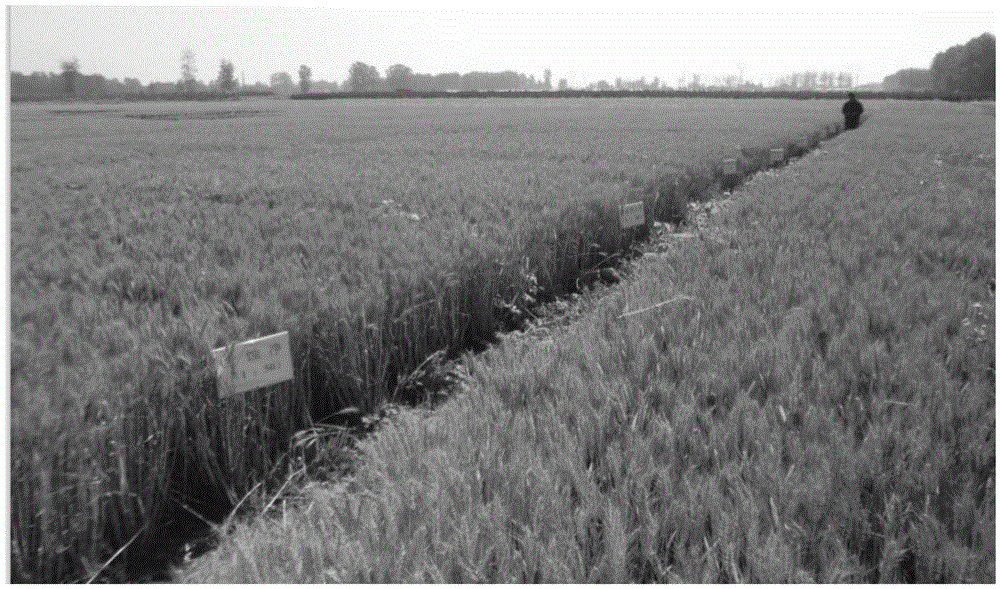Application of 4-chlorocinnamaldehyde thiosemicarbazide in the control of plant diseases
A technology of cinnamaldehyde thiosemicarbazone and cinnamaldehyde amino shrinkage, which is applied in the field of agricultural plant protection, can solve the problems of reduced efficacy of fungicides, and achieve good control effect, good systemic conduction activity, and safe emergence
- Summary
- Abstract
- Description
- Claims
- Application Information
AI Technical Summary
Problems solved by technology
Method used
Image
Examples
Embodiment 14
[0020] The bacteriostatic activity of embodiment 14-chlorocinnamaldehyde thiosemicarbazone to wheat take-all and Rhizoctonia graminearum
[0021] 1. Materials and methods
[0022] 1.1 Test materials
[0023] 1.1.1 Tested strains
[0024] Wheat take-all strain (Gaeumammomyces graminisvar.tritici) XX1 (provided by China Agricultural University)
[0025] Wheat sheath blight strain (Rhizoctonia acerealis) RC1 (provided by China Agricultural University)
[0026] 1.1.2 Drugs to be tested
[0027] 4-chlorocinnamaldehyde thiosemicarbazone (a yellow powder with a purity of 97%, provided by the College of Science, China Agricultural University)
[0028] 1.1.3 Preparation of medium
[0029] Preparation of Potato Dextrose Medium (PDA): Weigh 200g of peeled potatoes and cut into small pieces, add 1000ml of water and boil for half an hour, filter out the potato pieces with gauze, add water to make up 1000ml, then add 18g of glucose and 15g of agar, heat the agar After it is completely...
Embodiment 24
[0045] Example 24- Field control effect of chlorocinnamaldehyde thiosemicarbazone on wheat take-all and wheat sheath blight
[0046] 1. Materials and methods
[0047] 1.1 Test materials
[0048] 1.1.1 Wheat varieties
[0049] Zhou Mai 22
[0050] 1.1.2 Drugs to be tested
[0051] Test agents: 5% 4-chlorocinnamaldehyde thiosemicarbazone suspension concentrate, 12.5% total eclipse (silthiopham, Silthiopham) suspension concentrate, 3% difenoconazole suspension concentrate.
[0052] Wherein, the preparation method of 5% 4-chlorocinnamaldehyde thiosemicarbazone suspension concentrate is as follows: adopt wet grinding method, with 4% surfactant 0201B, 1% high-purity sodium bentonite A, 5% 4-chloro Cinnamaldehyde thiosemicarbazone, 0.4% warning color (basic rhodamine), 2% ethylene glycol and water are successively added to a sand mill and ground for 45 minutes, so that the particle size of the product reaches below 4.0 microns to obtain a suspending agent.
[0053] Among them,...
Embodiment 34
[0088] The control of embodiment 34-chlorocinnamaldehyde thiosemicarbazones to tomato gray mold
[0089] 1. Materials and methods
[0090] 1.1 Test materials
[0091] 1.1.1 Tested strains
[0092] Test strains: Botrytis cinerea strain FJ1-3 (provided by China Agricultural University)
[0093] 1.1.2 Drugs to be tested
[0094] 4-chlorocinnamaldehyde thiosemicarbazone (a yellow powder with a purity of 97%, provided by the College of Science, China Agricultural University)
[0095] 1.1.3 Preparation of medium
[0096] The preparation of potato dextrose medium (PDA) is the same as in Example 1.
[0097] 1.2 Test method
[0098] 1.2.1 The cultivation of pathogenic bacteria
[0099] Botrytis cinerea was inoculated on a PDA plate, and placed in an incubator at 18°C for 4 days in the dark.
[0100] 1.2.2 Indoor toxicity test
[0101] Prepare the test agent with dimethyl sulfoxide to a concentration of 1×10 5 The μg / ml mother solution was stored in a refrigerator at 4°C, an...
PUM
 Login to View More
Login to View More Abstract
Description
Claims
Application Information
 Login to View More
Login to View More - R&D Engineer
- R&D Manager
- IP Professional
- Industry Leading Data Capabilities
- Powerful AI technology
- Patent DNA Extraction
Browse by: Latest US Patents, China's latest patents, Technical Efficacy Thesaurus, Application Domain, Technology Topic, Popular Technical Reports.
© 2024 PatSnap. All rights reserved.Legal|Privacy policy|Modern Slavery Act Transparency Statement|Sitemap|About US| Contact US: help@patsnap.com










